Abstract
Voice symptoms are frequently reported early after thyroidectomy, even in the absence of laryngeal nerves injury. We evaluated the short-term outcomes of these functional alterations. Thirty-nine patients were enrolled in a prospective observational trial, evaluating voice function before and 3 months after uncomplicated thyroidectomy, using VoiSS as assessed using a validated patient rated questionnaire; and perceptual voice analysis using GRBAS scale (Grade, Roughness, Breathiness, Asthenia, Strain). Impact of dysphonia on patient’s life using VoiSS questionnaire revealed differences between pre- and postoperative assessment. There was statistically significant worsening in the impairment subgroup of VoiSS (p = 0.027). GRBAS evaluation was consistent between the three independent raters but showed differences between pre- and postoperative voice assessment. Age, TSH and a preoperative finding of laryngopharyngeal reflux significantly predicted quality of voice after thyroid surgery (all p < 0.004), as identified by the GRBAS assessment tool, but not type of surgery, gender or smoking status; although prediction of total variance in changes of voice was modest (r 2 = 0.07). Voice changes may occur after thyroidectomy without evident laryngeal nerve injury. Patients should be made aware of possible mild changes in voice even after uncomplicated thyroid surgery and this might be considered to be part of the informed consent.

Similar content being viewed by others
References
Chandrasekhar SS, Randolph GW, Seidman MD, Rosenfeld RM, Angelos P, Barkmeier-Kraemer J, Benninger MS, Blumin JH, Dennis G, Hanks J, Haymart MR, Kloos RT, Seals B, Schreibstein JM, Thomas MA, Waddington C, Warren B, Robertson PJ, American Academy of O-H, Neck S (2013) Clinical practice guideline: improving voice outcomes after thyroid surgery. Otolaryngol Head Neck Surg 148(6 Suppl):S1–37. doi:10.1177/0194599813487301
Hong KH, Kim YK (1997) Phonatory characteristics of patients undergoing thyroidectomy without laryngeal nerve injury. Otolaryngol Head Neck Surg 117(4):399–404
Minni A, Ruoppolo G, Barbaro M, Di Lorenzo E, Sementilli G, Bononi M (2014) Long-term (12 to 18 months) functional voice assessment to detect voice alterations after thyroidectomy. Eur Rev Med Pharmacol Sci 18(12):1704–1708
Henry LR, Helou LB, Solomon NP, Howard RS, Gurevich-Uvena J, Coppit G, Stojadinovic A (2010) Functional voice outcomes after thyroidectomy: an assessment of the Dsyphonia Severity Index (DSI) after thyroidectomy. Surgery 147(6):861–870. doi:10.1016/j.surg.2009.11.017
Stojadinovic A, Henry LR, Howard RS, Gurevich-Uvena J, Makashay MJ, Coppit GL, Shriver CD, Solomon NP (2008) Prospective trial of voice outcomes after thyroidectomy: evaluation of patient-reported and clinician-determined voice assessments in identifying postthyroidectomy dysphonia. Surgery 143(6):732–742. doi:10.1016/j.surg.2007.12.004
Wilson JA, Webb A, Carding PN, Steen IN, MacKenzie K, Deary IJ (2004) The Voice Symptom Scale (VoiSS) and the Vocal Handicap Index (VHI): a comparison of structure and content. Clin Otolaryngol Allied Sci 29(2):169–174. doi:10.1111/j.0307-7772.2004.00775.x
Akyildiz S, Ogut F, Akyildiz M, Engin EZ (2008) A multivariate analysis of objective voice changes after thyroidectomy without laryngeal nerve injury. Arch Otolaryngol Head Neck Surg 134(6):596–602. doi:10.1001/archotol.134.6.596
Lombardi CP, Raffaelli M, D’Alatri L, Marchese MR, Rigante M, Paludetti G, Bellantone R (2006) Voice and swallowing changes after thyroidectomy in patients without inferior laryngeal nerve injuries. Surgery 140(6):1026–1032. doi:10.1016/j.surg.2006.08.008 (discussion 1032–1024)
Lombardi CP, Raffaelli M, De Crea C, D’Alatri L, Maccora D, Marchese MR, Paludetti G, Bellantone R (2009) Long-term outcome of functional post-thyroidectomy voice and swallowing symptoms. Surgery 146(6):1174–1181. doi:10.1016/j.surg.2009.09.010
de Pedro Netto I, Fae A, Vartanian JG, Barros AP, Correia LM, Toledo RN, Testa JR, Nishimoto IN, Kowalski LP, Carrara-de Angelis E (2006) Voice and vocal self-assessment after thyroidectomy. Head Neck 28(12):1106–1114. doi:10.1002/hed.20480
Sinagra DL, Montesinos MR, Tacchi VA, Moreno JC, Falco JE, Mezzadri NA, Debonis DL, Curutchet HP (2004) Voice changes after thyroidectomy without recurrent laryngeal nerve injury. J Am Coll Surg 199(4):556–560. doi:10.1016/j.jamcollsurg.2004.06.020
Deary IJ, Wilson JA, Carding PN, MacKenzie K (2003) VoiSS: a patient-derived Voice Symptom Scale. J Psychosom Res 54(5):483–489
Mehanna R, Hennessy A, Mannion S, O’Leary G, Sheahan P (2015) Effect of endotracheal tube size on vocal outcomes after thyroidectomy: a randomized clinical trial. JAMA Otolaryngol Head Neck Surg 141(8):690–695. doi:10.1001/jamaoto.2015.1198
Department UH (2012) Does-my-project-require-rec- review. http://www.hra.nhs.uk/documents/2013/09/does-my-project-require-rec-reviewpdf. Accessed 17 May 2016
Belafsky PC, Postma GN, Koufman JA (2002) Validity and reliability of the reflux symptom index (RSI). J Voice 16(2):274–277
Van Lierde K, D’Haeseleer E, Wuyts FL, Baudonck N, Bernaert L, Vermeersch H (2010) Impact of thyroidectomy without laryngeal nerve injury on vocal quality characteristics: an objective multiparameter approach. Laryngoscope 120(2):338–345. doi:10.1002/lary.20762
Nasiri S, Shafag S, Khorgami Z, Sodagari N, Aminian A, Hedayat A (2013) Does corticosteroid have any beneficial effect on voice change after thyroidectomy? Am Surg 79(12):1258–1262
Acknowledgments
Hisham Mehanna for methodological guidance; June Jones and Gemma M. Jones for support with data collection.
Author information
Authors and Affiliations
Corresponding author
Ethics declarations
Conflict of interest
None.
Rights and permissions
About this article
Cite this article
Tedla, M., Chakrabarti, S., Suchankova, M. et al. Voice outcomes after thyroidectomy without superior and recurrent laryngeal nerve injury: VoiSS questionnaire and GRBAS tool assessment. Eur Arch Otorhinolaryngol 273, 4543–4547 (2016). https://doi.org/10.1007/s00405-016-4163-6
Received:
Accepted:
Published:
Issue Date:
DOI: https://doi.org/10.1007/s00405-016-4163-6




